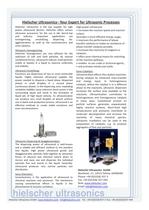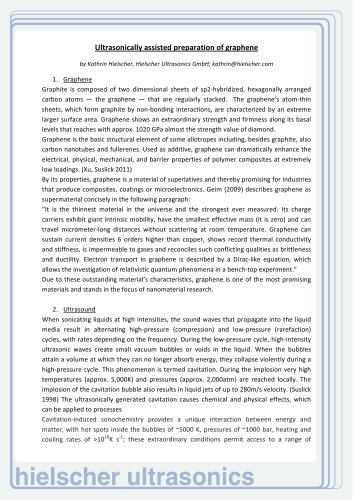
Catalog excerpts

Hielscher Ultrasonics-Your Expert for Ultrasonic Processes Hielscher Ultrasonics is the top supplier for high power ultrasound devices. Hielscher offers various ultrasonic processors for the use in lab, bench-top and industry. Important applications are homogenizing, emulsifying, dispersing, de- agglomeration as well as the sonochemistry and sono-cata lysis. Ultrasonic Homogenizing: Hielscher homogenizers are very efficient for the reduction of soft and hard particles. By intense cavitational forces, ultrasound reduces small particles (solids or liquids) in a liquid to improve uniformity Ultrasonic Emulsifying: Emulsions are dispersions of two or more immiscible liquids. Highly intensive ultrasound supplies the power needed to disperse a liquid phase (dispersed phase) in small droplets in a second phase (continuous phase). In the dispersing zone, imploding cavitation bubbles cause intensive Shockwaves in the surrounding liquid and result in the formation of liquid jets of high liquid velocity. As ultrasonication can produce very small droplets of almost uniform size in batch and production process, ultrasound is an effective methods to create stable emulsions and even microemulsions. Ultrasonic Dispersing & Deagglomeration: The dispersing power of ultrasound is well-known and a reliable and efficient method to mix powders into liquids. High power ultrasound grinds and deagglomerates particles held together by attraction forces of physical and chemical nature down to micron and nano size and disperses the individual particles fine and evenly in the liquid. Generally, ultrasound produces very narrow particles size Sonochemistry is the application of ultrasound to chemical reactions and processes. The mechanism causing sonochemical effects in liquids is the phenomenon of acoustic cavitation. High power ultrasound • increases the reaction speed and reaction provides a more efficient energy usage, • improves the performance of phase transfer catalysts or makes an avoidance of phase transfer catalysts possible, • increases the reactivity of reagents or • offers sono-chemical means for switching • enables to use crude or technical agents, • and activates metals and solids. Sono-Cata lysis: Ultrasonication affects the catalyst reactivity during catalysis by enhanced mass-transfer and energy input. In heterogeneous catalysis, where the catalyst is in a different phase to the reactants, ultrasonic dispersion increases the surface area available to the reactants. Ultrasonication contributes to heterogeneous and homogeneous catalysis in many ways. Cavitational erosion on particle surfaces generates unpassivated, highly reactive surfaces. Short-lived high temperatures and pressures contribute to molecular decomposition and increase the reactivity of many chemical species. Ultrasonic irradiation can be used in the preparation of catalysts, e.g. to produce aggregates of fine-size particles. Hielscher Ultrasonics GmbH Warthestr. 21, 14513 Teltow, GERMANY hielscher ultrasonics Hielscher Ultrasonics GmbH www.hielscher.com; info@hielscher.com Tel.: +49 (0)3328/437-3 Fax: +49 (0)3328/437-444
Open the catalog to page 1All Hielscher catalogs and technical brochures
-
Ultrasonic Process Lab
1 Pages
-
Ultrasonic Wire Cleaning
4 Pages
-
Hielscher Ultrasonic Sieves
2 Pages



















